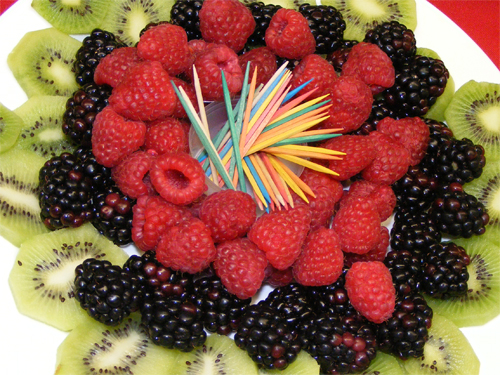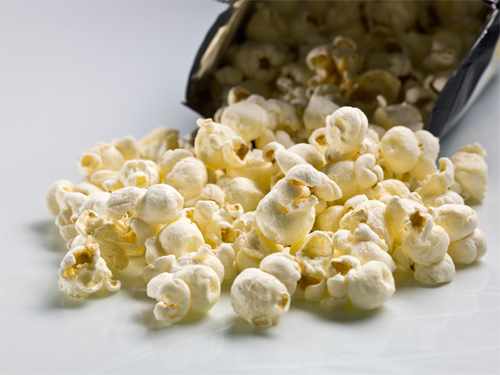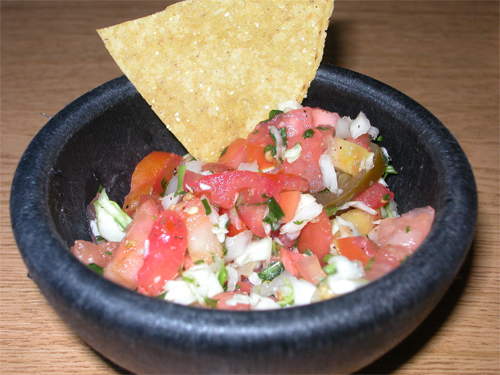
Fact Sheet FS1049
Yummy Snacks
Crunchy or chewy
- Baked corn chips & salsa
- Low-fat or air-popped popcorn
- Pretzels
- Rice cakes with peanut butter
- Veggies & low-fat dip
- Low-fat bean dip & crackers
- Hummus & vegetables
- Low-fat trail mix
- Vanilla wafers, animal crackers or ginger snaps
- Graham crackers
- Dried fruit (¼ cup portion)
- Whole grain crackers with a 100% fruit spread
- Nuts (¼ cup portion)
Smooth or creamy
- Low-fat cheese
- Low-fat cottage cheese & fruit
- Low-fat yogurt
- Low-fat fruit smoothie
- Fruit- fresh, canned in juice or frozen
- Low-fat pudding
More Snacks
Icy
- Frozen fruit bars
- Low-fat frozen yogurt or ice cream
- Low-sugar ice pops or make your own with 100% fruit juice
- Frozen fruit – thaw slightly before eating
- Frozen banana slices dipped in chocolate sauce
Thirst-quenching
- Water (plain or flavored with fruit slices)
- Non-fat or low-fat milk
- 100% juice (add seltzer for a fizz)
- Seltzer
- Low-fat hot chocolate
- Low-fat yogurt drink
- Tea
Recipes
Fruity Smoothie
Serves 2
Choose your favorite in-season, canned, or slightly thawed frozen fruit.
1 cup ripe mango (or other fruit), cut into small pieces
8 ounces of low-fat yogurt
½ of a frozen banana
Mix in a blender until smooth but still thick.
OR
Partially thaw the banana, mash the fruit and then place all ingredients in a tightly sealed container. Shake until well mixed. The drink will be a little lumpy, but delicious.
Pour into 2 glasses.
Tortilla Pizza
Serves 1
Make these in a microwave oven for a fast treat. This is a good recipe for children. Supervise children during cooking.
1–6 inch whole wheat flour tortilla
3 tablespoons tomato or spaghetti sauce
2 tablespoons shredded low-fat cheese (mozzarella, cheddar, Monterey Jack or other)
2 tablespoons chopped vegetables—red or green pepper, mushrooms, or onion
- Place tortilla on a paper plate if using the microwave oven or a foil-covered tray, if using the regular oven. Preheat the regular oven to 400°F.
- Spread tortilla with spaghetti sauce.
- Add shredded cheese on top of sauce.
- Sprinkle on the chopped vegetables.
- Cook or bake the tortilla in a microwave oven for 30 seconds or in a regular oven for about 5 minutes, until the cheese melts.
- Remove carefully. The plate or tray and food will be hot.
- Cool slightly before eating. Enjoy.
Websites for Healthy Eating Information
It is midafternoon and the kids are hungry. What should you give them? How about parties for birthdays, holidays, sports banquets or retirements? What do you serve or eat? Food and celebrations go together. Do we have to give up snacks, parties, and favorite treats to be healthy? No. It's OK to have cake and ice cream, just not all of the time. The key is moderation. It's making healthy choices most of the time, so we live long, healthy lives.
Health Concerns
The obesity epidemic and high numbers of people with chronic diseases such as diabetes, heart disease, and high blood pressure are major health concerns. In addition, more and more children are overweight and at risk for these diseases. Many people eat too much food, or regularly eat fatty, sugary, or salty foods, resulting in weight gain and increased risk for chronic diseases. Some children and adults snack all day long. Those calories add up.
Schools, in cooperation with families and school wellness councils, have adopted policies to improve school meals and the school environment in an effort to make children healthier. Schools limit the availability of sugarsweetened beverages and unhealthy snacks during the school day. Schools encourage serving healthy foods like fruit, and playing games at celebrations.
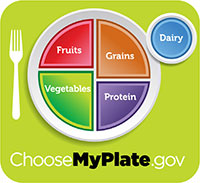
Healthy Eating
According to ChooseMyPlate.gov, a healthy plate is ½ vegetables and fruits, ¼ grains (mostly whole grains), ¼ lean protein and includes low-fat dairy. Here are other tips:
- Eat and drink in moderation. Serve and eat reasonable portions of food and beverages, especially those that are high in calories. Use small plates to control portion size.
- Aim to eat healthy most of the time. If you eat a high-fat food at one meal, make the rest of your meals low-fat. If you splurge on high calorie foods at a party, make better choices the next day.
- Eat more vegetables and fruits. Research shows that eating a diet rich in vegetables and fruits each day may protect us from stroke, heart disease, diabetes, some cancers, and may help control weight. Choose fresh, frozen, or canned (low sugar, low salt options) vegetables and fruits.
- Choose foods low in fat.
- Choose foods low in sugar, particularly added sugars.
- Choose whole grains, such as whole wheat, whole oats, barley, brown rice, or air-popped, unbuttered popcorn.
Snacks or Treats?
Snacks help us get all of the nutrients and calories we need during the day. This is especially true for young, active children who cannot consume all their caloric needs in three meals. Snacks also keep us from getting so hungry that we overeat at meals. Treats are foods or beverages served for special occasions. Treats might include fried foods, French fries, cake, cookies, candy, or soda. Treats should not be eaten every day, but rather once in a while.
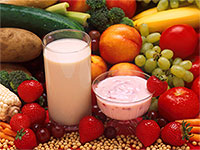
Healthy snacks.
Healthy Snack Tips:
- Children and adults do not need to eat all hours of the day or evening.
- Allow time between meals and snacks to be sure you are hungry. For example, wait two hours after a meal for a snack. It is helpful for young children to have set snack times, for example 10:30 am and 3:30 pm. Snacking constantly results in consuming too many calories.
- Children and adults do not need snacks at every meeting, on every car ride, or after every sports practice or game. Water is enough.
- Make snacking easy by having healthful foods available at home, work, and when traveling.
-
Make your own "grab & go" snacks. Examples:
- Keep washed fruit (apples, bananas, berries, grapes, oranges, pears) in a bowl on the counter or in the refrigerator.
- Purchase or prepare bite size veggies and fruits such as carrots, jicama, peppers, grape tomatoes, mango, or pineapple. Store in individual plastic bags in the refrigerator.
- Bag your own portion size popcorn, low fat crackers, granola or pretzels.
- Wash blueberries or strawberries, dry on paper towels and then freeze on a tray. Once frozen, put ½ cup portions in small plastic bags or containers and store in the freezer. Thaw slightly before eating.
- Insert a wooden stick into ½ a banana, roll in chopped nuts or coconut (optional), wrap in foil and freeze. Thaw slightly before eating.
- Serve snacks, such as pretzels, in small individual dishes to control portion size rather than putting out a large bowl.
- Sit at a table for snacks. Avoid mindless snacking in front of the TV or computer.
Healthy Beverage Tips:
- Drink water. Sometimes we think we are hungry, when we are really thirsty. Drink water to quench thirst and control calories.
- Serve reasonable size beverage portions, about eight ounces.
-
Choose 100% juice. MyPlate encourages eating fruit and vegetables rather than drinking lots of juice since whole foods have fiber and fill us up.
- Depending on age, children may drink ½ to 1 cup, and adults may drink up to 1 cup of 100% fruit or vegetable juice each day.
- Read drink labels. Some juice drinks contain little fruit juice and are high in sugar.
- Another trick to reduce calories is to dilute juice with an equal amount of water or seltzer.
- Limit drinking high calorie beverages such as soda, fruit drinks, sports drinks, energy drinks and alcoholic beverages.
Parties
- Focus on fun and conversation.
- Plan active parties. Dance and play games like volleyball or tag. Encourage kids to run around. Take a walk before or after a meal.
- Children enjoy dressing up (hats, crowns, costumes) and making noise (horns, kazoos) at parties.
- Plan a healthy menu with foods low in fat, sugar, and salt. Serve one or two food choices, so people do not feel they need to try some of everything.
- Serve small portions. Examples: mini bagels, half sandwiches, mini muffins, 4-ounce burgers, small rolls, or mini cupcakes.
- Always serve green salads, fresh veggies and dip, fruit, fresh and/or cooked vegetables.
- Serve small portions of any high-fat or high-sugar foods. Choose healthier options when available, such as lower fat ice creams, frozen yogurt, frozen juice pops, baked chips, hummus, low fat dips, etc.
- Always provide water as a beverage choice. Other healthful beverages: non-fat or low-fat milk, 100% juice, seltzer, and low-fat, low sugar yogurt drinks.
- Feed children a normal meal or snack before a party so they do not overeat during the event. Other children may be too busy or excited to eat at the party.
- Adults also benefit by eating normally before a party. If you starve all day, you are more likely to overeat or drink later.
January 2014
Copyright © 2025 Rutgers, The State University of New Jersey. All rights reserved.
For more information: njaes.rutgers.edu.
Cooperating Agencies: Rutgers, The State University of New Jersey, U.S. Department of Agriculture, and Boards of County Commissioners. Rutgers Cooperative Extension, a unit of the Rutgers New Jersey Agricultural Experiment Station, is an equal opportunity program provider and employer.


